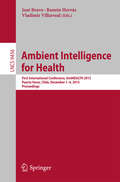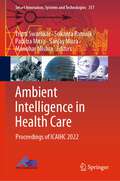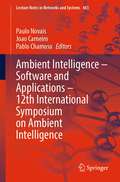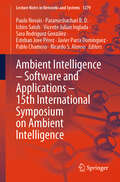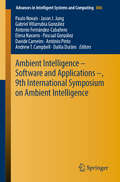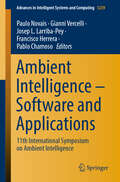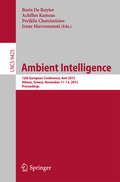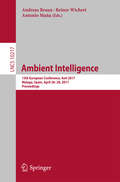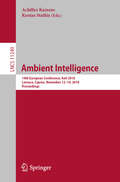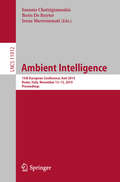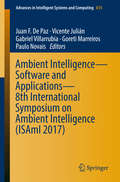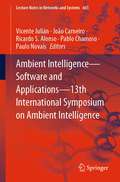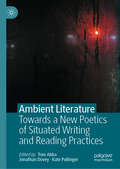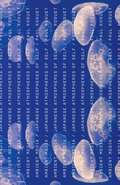- Table View
- List View
Ambient Intelligence for Health: First International Conference, AmIHEALTH 2015, Puerto Varas, Chile, December 1-4, 2015, Proceedings (Lecture Notes in Computer Science #9456)
by Ramón Hervás José Bravo Vladimir VillarrealThis book constitutes the refereed conference proceedingsof the First International Conference on Ambient Intelligence for Health,AmIHEALTH 2015, held in Puerto Varas, Chile, in December 2015. The 20 revised full papers and 9 short papers werereviewed and selected from 32 submissions and cover topics on technologies forimplementing AmIHealth environments; frameworks related with AmIHealthenvironments; applied algorithms in e-Health systems; interactions within theAmIHealth environments; applications and case studies of AmIHealthenvironments; and metrics for health environments.
Ambient Intelligence in Health Care: Proceedings of ICAIHC 2022 (Smart Innovation, Systems and Technologies #317)
by Pabitra Mitra Srikanta Patnaik Sanjay Misra Manohar Mishra Tripti SwarnkarThe book is a collection of research papers presented at the First International Conference on International Conference on Ambient Intelligence in Health Care (ICAIHC 2021) organized by Institute of Technical Education and Research, Siksha ‘O’ Anusandhan (Deemed to be University) University, Bhubaneswar, India, during April 15–16, 2022. It includes papers in the research area of e-health care, telemedicine, other medical technologies, life support systems, fast detection and diagnoses, developed technologies and innovative solutions, bioinformatics, and solutions for monitoring smart intelligent systems in health care.
Ambient Intelligence – Software and Applications – 12th International Symposium on Ambient Intelligence (Lecture Notes in Networks and Systems #483)
by Paulo Novais Pablo Chamoso Joao CarneiroThis book presents the latest research on Ambient Intelligence (AmI) including software and applications in different areas such as Internet of Things, Multi-Agent Systems or e-Learning, among others. AmI is a paradigm emerging from Artificial Intelligence, in which computers are used as proactive tools for assisting people with their day-to-day activities, making everyone’s lives more comfortable. Another main concern of AmI originates from the human–computer interaction domain and focuses on offering ways to interact with systems in a more natural way by means of user-friendly interfaces. The published book correspond to technical and novel works carried out by scientists conducting research within the AmI area in one of the areas mentioned above. The intended readers are those with mainly technical profiles who are already working in the area of AmI or who want to focus their current work in this area.The papers collected in this book were presented at a symposium which was jointly organized by the Universidade do Minho and University of Salamanca. The latest installment was held in Salamanca, Spain, from October 6th to 8th, 2021. The authors wish to thank the sponsors: IBM, Indra, Viewnext, Global Exchange, AEPIA, APPIA and AIR Institute.
Ambient Intelligence – Software and Applications – 14th International Symposium on Ambient Intelligence (Lecture Notes in Networks and Systems #770)
by Davide Carneiro Paulo Novais Vicente Julián Inglada João Carneiro Ichiro Satoh Ricardo S. Alonso Miguel J. HornosThis book presents the latest research on Ambient Intelligence (AmI) presented in the 14th International Symposium on Ambient Intelligence (ISAmI 2023). Among others, interested researchers can find works on the recognition of emotions and life conditions; smart applications for improving people’s quality of life and safety; smart cities and territories; as well as advances in data semantics, organization, and privacy, among others. The symposium was organized by the Universidade do Minho (Portugal), the Universitat Politècnica de València (Spain), the University of Granada (Spain), the National Institute of Informatics (Japan), the Instituto Superior de Engenharia do Porto (Portugal), the Universidad de Salamanca (Spain), and with the AIR Institute (Spain) as sponsor. The present edition was hosted by the LASI and Centro Algoritmi of the University of Minho in Guimarães (Portugal) from July 12 to 14, 2023.
Ambient Intelligence – Software and Applications – 15th International Symposium on Ambient Intelligence (Lecture Notes in Networks and Systems #1279)
by Paulo Novais Pablo Chamoso Sara Rodríguez González Ichiro Satoh Ricardo S. Alonso Esteban Jove Pérez Vicente Julian Inglada Parameshachari B. D. Javier Parra DomínguezThis book presents the latest research on Ambient Intelligence presented in the 15th International Symposium on Ambient Intelligence (ISAmI 2024). Interested researchers can find works on intelligent systems on healthcare and security scenarios; smart cities and urban environments; active intelligent mobility; Internet of Things in Industry 4.0; Ambient-Assisted Living; as well as quantum computing in economics, industrial and social applications; among others. The symposium was organized by the Universidade do Minho (Portugal), the Nitte Meenakshi Institute of Technology (India), the National Institute of Informatics (Japan), the Università degli Studi di Genova (Italy), the Universitat Politècnica de València, the University of Salamanca, the University of Granada, and the AIR Institute (Spain). The present edition was hosted within the Salamanca Tech Summit by the BISITE Research Group, the AIR Institute and the City Council in Salamanca, Spain, from June 26th to 28th, 2024.
Ambient Intelligence – Software and Applications –, 9th International Symposium on Ambient Intelligence (Advances In Intelligent Systems and Computing #806)
by Jason J. Jung Davide Carneiro Paulo Novais Gabriel Villarrubia González Antonio Fernández-Caballero Andrew T. Campbell Pascual González Elena Navarro António Pinto Dalila DurãesThe aim of the book is to introduce new developments in Ambient Intelligence from researchers of several countries. The book includes different works in the area of Ubiquitous Computing, e-Health, Ambient Assisted Living, Distributed Computing and Context Aware Computing that have been selected by an international committee. The studies have been presented in the 9th International Symposium on Ambient Intelligence held in Toledo in June 2018.
Ambient Intelligence – Software and Applications –,10th International Symposium on Ambient Intelligence (Advances in Intelligent Systems and Computing #1006)
by Davide Carneiro Paulo Novais Jaime Lloret Sigeru Omatu Elena Navarro Pablo ChamosoThis book presents the latest research on Ambient Intelligence including software and applications. Ambient Intelligence (AmI) is a paradigm emerging from Artificial Intelligence, in which computers are used as proactive tools for assisting people with their day-to-day activities, making everyone’s lives more comfortable. Another main concern of AmI originates from the human–computer interaction domain and focuses on offering ways to interact with systems in a more natural way by means of user-friendly interfaces. This field is evolving rapidly, as can be seen in emerging natural language and gesture-based types of interaction. This symposium was jointly organized by the Universidade do Minho, Technical University of Valencia, Hiroshima University, and University of Salamanca. The latest installment was held in Ávila, Spain, from 26th to 28th June 2019. The authors wish to thank the sponsors: IEEE Systems Man and Cybernetics Society, Spain Section Chapter and the IEEE Spain Section (Technical Co-Sponsor), IBM, Indra, Viewnext, Global Exchange, AEPIA, APPIA and AIR Institute.
Ambient Intelligence – Software and Applications: 11th International Symposium on Ambient Intelligence (Advances in Intelligent Systems and Computing #1239)
by Paulo Novais Francisco Herrera Pablo Chamoso Gianni Vercelli Josep L. Larriba-PeyThis book includes the outcomes of the 11th International Symposium on Ambient Intelligence (ISAmI 2020). The 11th International Symposium on Ambient Intelligence is hosted by the University of L’Aquila and is going to be held in L’Aquila (Italy). Initially planned on the 17th to the 19th of June 2020, it was postponed to the 7th to the 9th of October 2020, due to the COVID-19 outbreak.
Ambient Intelligence: 12th European Conference, AmI 2015, Athens, Greece, November 11-13, 2015, Proceedings (Lecture Notes in Computer Science #9425)
by Boris De Ruyter Achilles Kameas Periklis Chatzimisios Irene MavrommatiThis book constitutes the refereed proceedings of the 12th European Conference on Ambient Intelligence, AmI 2015, held in Athens, Greece, in November 2015. The 21 revised full papers presented together with 5 short papers were carefully reviewed and selected from 48 submissions. Over the past 20 years, the vision of Ambient Intelligence has gradually materialized into a plethora of technologies and devices, which are being introduced into almost every aspect of everyday life, thus affecting our abilities, activities, behavior and in the end,shaping a new way of thinking.
Ambient Intelligence: 13th European Conference, AmI 2017, Malaga, Spain, April 26–28, 2017, Proceedings (Lecture Notes in Computer Science #10217)
by Andreas Braun Reiner Wichert Antonio MañaThis book constitutes the refereed proceedings of the 13th European Conference on Ambient Intelligence, AmI 2017, held in Malaga, Spain, in April 2017. The 16 revised full papers presented together with 4 short papers and 1 keynote paper were carefully reviewed and selected from 48 submissions. The papers cover topics such as: Enabling technologies, methods and platforms; objectives and approaches of ambient intelligence and internet of things; from information design to interaction and experience design, and application areas of AmI and IoT.
Ambient Intelligence: 14th European Conference, AmI 2018, Larnaca, Cyprus, November 12-14, 2018, Proceedings (Lecture Notes in Computer Science #11249)
by Achilles Kameas Kostas StathisThis book constitutes the refereed proceedings of the 14th European Conference on Ambient Intelligence, AmI 2018, held in Larnaca, Cyprus, in November 2018. The 12 revised full papers presented together with 6 short papers were carefully reviewed and selected from 36 submissions. The papers cover topics such as: Ambient Services and Smart Environments; Sensor Networks and Artificial Intelligence; Activity and Situation Recognition; Ambient Intelligence in Education.
Ambient Intelligence: 15th European Conference, AmI 2019, Rome, Italy, November 13–15, 2019, Proceedings (Lecture Notes in Computer Science #11912)
by Boris De Ruyter Irene Mavrommati Ioannis ChatzigiannakisThis book constitutes the refereed proceedings of the 15th European Conference on Ambient Intelligence, AmI 2019, held in Rome, Italy, in November 2019. The 20 full papers presented together with 10 short papers were carefully reviewed and selected from 50 submissions. The papers cover topics such as embedded devices that can merge unobtrusively and in natural ways using information and intelligence hidden in the network connecting these devices (e.g., the Internet of Things). The main topic of AmI 2019 was “Data-driven Ambient Intelligence,” which follows the vision of Calm Technology, where technology is useful but does not demand our full attention or interfere with our usual behavior and activities.
Ambient Intelligence– Software and Applications – 8th International Symposium on Ambient Intelligence (Advances in Intelligent Systems and Computing #615)
by Paulo Novais Vicente Julián Juan F. De Paz Gabriel Villarrubia Goreti MarreirosAmbient Intelligence (AmI) is a recent paradigm emerging from Artificial Intelligence, in which computers are used as proactive tools to assist people with their day-to-day activities, making their lives more comfortable. Another main goal of AmI originates from the human/computer interaction domain and focuses on offering ways to interact with systems in a more natural way by means of user-friendly interfaces. This field is evolving quickly, as can be witnessed by the emerging natural-language-based and gesture-based types of interaction. The inclusion of computational power and communication technologies in everyday objects is growing, and their embeddedness in our environments should be as invisible as possible. In order for AmI to be successful, human interaction with computing power and embedded systems in the surroundings should be smooth and take place without people actually noticing it. The only things people should notice in connection with AmI are more safety, comfort and wellbeing, emerging in a natural and inherent way. ISAmI is the International Symposium on Ambient Intelligence and aims to bring together researchers from the various disciplines that constitute the scientific field of Ambient Intelligence to present and discuss the latest results, new ideas, projects and lessons learned, especially in terms of software and applications.
Ambient Intelligence—Software and Applications—13th International Symposium on Ambient Intelligence (Lecture Notes in Networks and Systems #603)
by Paulo Novais Vicente Julián Pablo Chamoso João Carneiro Ricardo S. AlonsoThis book presents the latest research on Ambient Intelligence including software and applications. Ambient Intelligence (AmI) is a paradigm emerging from Artificial Intelligence, where computers are used as proactive tools assisting people with their day-to-day activities, making everyone’s life more comfortable. The inclusion of computational power and communication technologies in everyday objects is growing, and their embedding into our environments should be as invisible as possible. In order for AmI to be successful, human interaction with computing power and embedded systems in the surroundings should be smooth and happen without people actually noticing it. The only awareness people should have arises from AmI: more safety, comfort and wellbeing, emerging in a natural and inherent way. ISAmI is the International Symposium on Ambient Intelligence, aiming to bring together researchers from various disciplines that constitute the scientific field of AmI to present and discuss the latest results, new ideas, projects and lessons learned.
Ambient Literature: Towards a New Poetics of Situated Writing and Reading Practices
by Kate Pullinger Tom Abba Jonathan DoveyThis book considers how a combination of place-based writing and location responsive technologies produce new kinds of literary experiences. Building on the work done in the Ambient Literature Project (2016–2018), this books argues that these encounters constitute new literary forms, in which the authored text lies at the heart of an embodied and mediated experience. The visual, sonic, social and historic resources of place become the elements of a live and emergent mise-en-scène. Specific techniques of narration, including hallucination, memory, history, place based writing, and drama, as well as reworking of traditional storytelling forms combine with the work of app and user experience design, interaction, software authoring, and GIS (geographical information systems) to produce ambient experiences where the user reads a textual and sonic literary space. These experiences are temporary, ambiguous, and unpredictable in their meaning but unlike the theatre, the gallery, or the cinema they take place in the everyday shared world. The book explores the potentiality of a new literary form produced by the exchange between location-aware cultural objects, writers and readers. This book, and the work it explores, lays the ground for a new poetics of situated writing and reading practices.
Ambient Mass Spectroscopy Techniques in Food and the Environment (Food Analysis & Properties)
by Leo M.L. Nollet Basil K. MunjanjaAmbient mass spectrometry—that is the use of mass spec but in the atmospheric environment—has been widely employed in food and environmental analysis. Ambient Mass Spectroscopy Techniques in Food and the Environment presents the theoretical underpinnings of mass spectrometry, and the benefits and pitfalls of ambient mass spectrometry, as well as the latest developments of the technique, in the analysis of food and environmental parameters. It describes methods that enable the detection of surface materials like waxes, alkaloids, flavors, or pesticides by plainly exposing the corresponding items to the ionization region of the interface, without harm to samples. Features: Explains the theoretical aspects of ambient mass spectrometry Describes how to use ambient MS techniques for food safety, authenticity, and traceability screening Lists the benefits of ambient MS in analysis of food and environmental parameters Covers recent developments of ambient MS in analysis of food and environmental parameters The specialized work provides insight to professionals practicing in food and the environment, including food scientists, food engineers, food biotechnologists, chemical engineers, and those working in research labs, universities, and government regulatory agencies.
Ambient Media: Japanese Atmospheres of Self
by Paul RoquetAmbient Media examines music, video art, film, and literature as tools of atmospheric design in contemporary Japan, and what it means to use media as a resource for personal mood regulation. Paul Roquet traces the emergence of ambient styles from the environmental music and Erik Satie boom of the 1960s and 1970s to the more recent therapeutic emphasis on healing and relaxation.Focusing on how an atmosphere works to reshape those dwelling within it, Roquet shows how ambient aesthetics can provide affordances for reflective drift, rhythmic attunement, embodied security, and urban coexistence. Musicians, video artists, filmmakers, and novelists in Japan have expanded on Brian Eno&’s notion of the ambient as a style generating &“calm, and a space to think,&” exploring what it means to cultivate an ambivalent tranquility set against the uncertain horizons of an ever-shifting social landscape. Offering a new way of understanding the emphasis on &“reading the air&” in Japanese culture, Ambient Media documents both the adaptive and the alarming sides of the increasing deployment of mediated moods.Arguing against critiques of mood regulation that see it primarily as a form of social pacification, Roquet makes a case for understanding ambient media as a neoliberal response to older modes of collective attunement—one that enables the indirect shaping of social behavior while also allowing individuals to feel like they are the ones ultimately in control.
Ambient Play (Playful Thinking)
by Larissa Hjorth Ingrid RichardsonAn engaging look at how mobile games are increasingly part of our day-to-day lives and the ways that we interact across real as well as digital landscapes.We often play games on our mobile devices when we have some time to kill--waiting in line, pausing between tasks, stuck on a bus. We play in solitude or in company, alone in a bedroom or with others in the family room. In Ambient Play, Larissa Hjorth and Ingrid Richardson examine how mobile gameplay fits into our day-to-day lives. They show that as mobile games spread across different genres, platforms, practices, and contexts, they become an important way of experiencing and navigating a digitally saturated world. We are digital wayfarers, moving constantly among digital, social, and social worlds.
Ambient Sufism: Ritual Niches and the Social Work of Musical Form (Chicago Studies in Ethnomusicology)
by Richard C. JankowskyAmbient Sufism is a study of the intertwined musical lives of several ritual communities in Tunisia that invoke the healing powers of long-deceased Muslim saints through music-driven trance rituals. Richard C. Jankowsky illuminates the virtually undocumented role of women and minorities in shaping the ritual musical landscape of the region, with case studies on men’s and women’s Sufi orders, Jewish and black Tunisian healing musical troupes, and the popular music of hard-drinking laborers, as well as the cohorts involved in mass-mediated staged spectacles of ritual that continue to inject ritual sounds into the public sphere. He uses the term “ambient Sufism” to illuminate these adjacent ritual practices, each serving as a musical, social, and devotional-therapeutic niche while contributing to a larger, shared ecology of practices surrounding and invoking the figures of saints. And he argues that ritual musical form—that is, the large-scale structuring of ritual through musical organization—has agency; that is, form is revealing and constitutive of experience and encourages particular subjectivities. Ambient Sufism promises many useful ideas for ethnomusicology, anthropology, Islamic and religious studies, and North African studies.
Ambient Sufism: Ritual Niches and the Social Work of Musical Form (Chicago Studies in Ethnomusicology)
by Richard C. JankowskyAmbient Sufism is a study of the intertwined musical lives of several ritual communities in Tunisia that invoke the healing powers of long-deceased Muslim saints through music-driven trance rituals. Richard C. Jankowsky illuminates the virtually undocumented role of women and minorities in shaping the ritual musical landscape of the region, with case studies on men’s and women’s Sufi orders, Jewish and black Tunisian healing musical troupes, and the popular music of hard-drinking laborers, as well as the cohorts involved in mass-mediated staged spectacles of ritual that continue to inject ritual sounds into the public sphere. He uses the term “ambient Sufism” to illuminate these adjacent ritual practices, each serving as a musical, social, and devotional-therapeutic niche while contributing to a larger, shared ecology of practices surrounding and invoking the figures of saints. And he argues that ritual musical form—that is, the large-scale structuring of ritual through musical organization—has agency; that is, form is revealing and constitutive of experience and encourages particular subjectivities. Ambient Sufism promises many useful ideas for ethnomusicology, anthropology, Islamic and religious studies, and North African studies.
Ambient Sufism: Ritual Niches and the Social Work of Musical Form (Chicago Studies in Ethnomusicology)
by Richard C. JankowskyAmbient Sufism is a study of the intertwined musical lives of several ritual communities in Tunisia that invoke the healing powers of long-deceased Muslim saints through music-driven trance rituals. Richard C. Jankowsky illuminates the virtually undocumented role of women and minorities in shaping the ritual musical landscape of the region, with case studies on men’s and women’s Sufi orders, Jewish and black Tunisian healing musical troupes, and the popular music of hard-drinking laborers, as well as the cohorts involved in mass-mediated staged spectacles of ritual that continue to inject ritual sounds into the public sphere. He uses the term “ambient Sufism” to illuminate these adjacent ritual practices, each serving as a musical, social, and devotional-therapeutic niche while contributing to a larger, shared ecology of practices surrounding and invoking the figures of saints. And he argues that ritual musical form—that is, the large-scale structuring of ritual through musical organization—has agency; that is, form is revealing and constitutive of experience and encourages particular subjectivities. Ambient Sufism promises many useful ideas for ethnomusicology, anthropology, Islamic and religious studies, and North African studies.
Ambient Television: Visual Culture and Public Space
by Anna MccarthyAlthough we tend to think of television primarily as a household fixture, TV monitors outside the home are widespread: in bars, laundromats, and stores; conveying flight arrival and departure times in airports; uniting crowds at sports events and allaying boredom in waiting rooms; and helping to pass the time in workplaces of all kinds. In Ambient Television Anna McCarthy explores the significance of this pervasive phenomenon, tracing the forms of conflict, commerce, and community that television generates outside the home. Discussing the roles television has played in different institutions from 1945 to the present day, McCarthy draws on a wide array of sources. These include retail merchandising literature, TV industry trade journals, and journalistic discussions of public viewing, as well as the work of cultural geographers, architectural theorists, media scholars, and anthropologists. She also uses photography as a research tool, documenting the uses and meanings of television sets in the built environment, and focuses on such locations as the tavern and the department store to show how television is used to support very different ideas about gender, class, and consumption. Turning to contemporary examples, McCarthy discusses practices such as Turner Private Networks' efforts to transform waiting room populations into advertising audiences and the use of point-of-sale video that influences brand visibility and consumer behavior. Finally, she inquires into the activist potential of out-of-home television through a discussion of the video practices of two contemporary artists in everyday public settings. Scholars and students of cultural, visual, urban, American, film, and television studies will be interested in this thought-provoking, interdisciplinary book.
Ambient Temperature and Health in China
by Hualiang Lin Wenjun Ma Qiyong LiuThis book focuses on the Chinese health impact induced by ambient temperature variation, especially the epidemiology-based exposure-response relationship with the mortality and morbidity from respiratory, cardiovascular diseases, and mental health among Chinese population.A great number of epidemiological studies have reported that ambient temperature is closely associated with a wide range of health outcomes, such as mortality, cardiovascular and respiratory events, adverse birth outcome, and some infectious diseases, such as dengue fever, malaria. Although a number of epidemiological studies in western countries have evaluated the adverse health effects of ambient temperature, the exposure-response relationship from these countries cannot simply be applied to the Chinese population due to the large differences in temperature profile, exposure pattern, as well as the population vulnerability. This book will provide up-to-date estimates of the magnitude of adverse health effects of ambient temperature in the Chinese population. We hope to provide readers with a comprehensive and organized body of information in the area of Ambient Temperature and health.
Ambient: Ästhetik des Hintergrunds (Neue Perspektiven der Medienästhetik)
by Jens Schröter Gregor Schwering Dominik Maeder Till A. HeilmannMit der Bezeichnung Ambient verbinden sich jene zugleich unaufdringlichen wie hörintensiven Klänge und Klangfolgen, die der Musikproduzent Brian Eno als Spielart populärer Musik etabliert hat. Dieser Band fragt, wie der Einfluss der Ambient Music (= Hintergrundmusik) zu beschreiben ist. Außerdem fragt er nach den Übertragungen: Lässt sich das Konzept des Ambient auch als eine Ästhetik des Hintergrunds begreifen, das sich auch auf andere, ähnlich gelagerte Phänomene ausweiten lässt? Etwa auf Literatur oder Film, Computergraphik oder Flugzeugkabinen?
Ambigrammia: Between Creation and Discovery
by Douglas HofstadterOn the history and creation of ambigrams, by a pioneer of the practice &“Spellbinding and truly one-of-a-kind. . . . This is an absolute delight.&”—Publishers Weekly (starred review) In the 1960s and 1970s, a trio of imaginative individuals independently discovered that ordinary words and phrases could be given double readings by playfully distorting the letters composing them. These doubly readable words and phrases, if designed by an artistic eye and hand, could possess great visual beauty. Douglas Hofstadter named such calligraphic creations &“ambigrams,&” and over the decades he has designed thousands of them, as have his friends Scott Kim and John Langdon, the other main pioneers of the subtle art form he calls ambigrammia. ABCD (Hofstadter&’s informal title for this book) offers a sampler of hundreds of Hofstadter&’s ambigrams, along with a few dozen by Kim, Langdon, and others. With deep links to cognitive science, ABCD exhibits ambigrams of many types and shows how ambigrammia can be extended in surprising directions. All along the way, Hofstadter discusses creativity and its alter ego, &“discoverativity,&” revealing how the &“pocket sized creativity puzzles&” that constitute the art form are pervaded by these complementary qualities. ABCD is also notably autobiographical: Hofstadter vividly recounts how his life has been intimately intertwined with the creation/discovery of ambigrams in many countries and in many languages.
